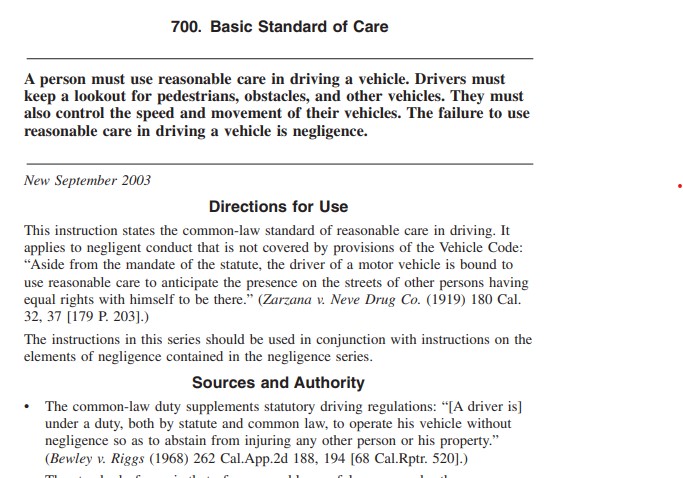Jury Instructions
Civil and Criminal Jury Instructions
At the end of a trial, but before the jurors deliberate, the judge reads them “jury instructions.” The instructions explain the laws that apply to the case.
Types of Jury Instructions
Usually, lawyers adapt these instructions from sets of standard jury instructions. In California, there are two main sets of civil jury instructions. One is an “official” plain-English set known as CACI (California Civil Jury Instructions). The other is BAJI (Book of Approved Jury Instructions). Either can be used. If there are no standard instructions that fit the case, “special instructions” are drafted. The special instructions must be based on California statutes or cases.
Purpose of Jury Instructions
Lawyers and litigants use jury instructions for three purposes:
- Starting point for legal research
- Checklist for gathering evidence and witnesses
- Framing the case for the jury at the end of trial
This guide describes each of these uses, then lists some of the resources in the Law Library and on the Internet.
Starting Point for Legal Research
Jury instructions tell what laws apply in simple language. Jury instruction books usually list the statutes, cases or regulations that apply. They are a good place to start your research, and some are even available free on the Internet. Important: The instructions are not “the law.” You must use cases, statutes or regulations to support your case when writing papers for court.
Instructions as source of basic legal standard
In every lawsuit the plaintiff has to list at least one cause of action – a specific legal claim, such as negligence, breach of contract, or medical malpractice, for which the plaintiff seeks compensation. (Nolo’s Free Dictionary of Law Terms and Legal Definitions.) To win, the plaintiff has to prove specific things about each cause of action. These are called elements. Unless there is evidence for every element, the plaintiff will lose.
For instance, to win a motor vehicle accident case, the plaintiff must prove that the defendant failed to meet the standard of care, which is outlined in CACI Instruction Number 700:

CACI No. 700 lists the basic standard of care for all drivers. Violating this standard of care is negligence, and proving that the defendant violated this standard of care will be necessary for the plaintiff to win this case.
CACI No. 700 is just the first instruction on motor vehicle accidents. The rest of the instructions in that series go into more detail about what the plaintiff must prove. For instance, CACI No. 701 defines the term “right of way.” To research or prove a motor vehicle accident, you will have to read all of the related instructions and consider which apply in your case.
Instructions as starting point for case law and statutory research
Each CACI instruction has a “Sources and Authority” section which contains citations to statutes and cases that support the point of law in the instruction. These are excellent starting places for research since they have been identified as relevant and definitive.
Checklist for Gathering Evidence and Witnesses
You can use jury instructions as a checklist to gather evidence and witnesses to prove your case. The instructions give you a list of elements. You can check this list to make sure you have evidence and testimony to prove each one. If you are the defendant, you can use the list to see if the plaintiff is missing any evidence. You can also use the jury instructions on defenses to make your own chart of what you need to prove.
For instance, a plaintiff trying to prove negligence in a motor accident case might make a chart based on CACI No. 700:
| Element | Defendant Failure | Witness(es) | Evidence/Documents | Notes |
|---|---|---|---|---|
| Defendant required to keep a lookout for pedestrians, obstacles, vehicles | Defendant did not notice red light or oncoming traffic | Officer Smith (#123) Witness Plaintiff | 1. According to all witnesses, defendant drove through a red light — did not even attempt to stop | There may have been a red light camera at the intersection. |
| Defendant required to control speed and movement of vehicle | Defendant did not stop at intersection | See Above | 2. No skid marks prior to collision. Photos taken by accident investigators, and Plaintiff. 3. According to all witnesses, defendant drove through a red light | See Above |
Framing the Case for the Jury
Before a trial, each party writes a set of instructions. Often the lawyers customize the instructions in CACI.
The instructions can influence the jury’s decision, so the parties frequently argue about the wording. The judge decides which version will be used. If the judge improperly refuses to use one of your proposed instructions, that can be grounds for an appeal.
Parties have to submit a complete set of instructions in a certain format on the first day of trial. (Sacramento Local Rule 2.97). The format is set out in Cal. Rule of Court 2.1055. The procedure for presenting your version of the jury instructions and arguing for their adoption is set out in California Code of Civil Procedure (CCP) 607a.
Resources Available in the Law Library
Civil Cases, California
CACI (California Civil Jury Instructions) KFC1047 .A65 W48
The CACI (pronounced “kay-see”) set is California’s “official” set of plain-English instructions, published by the California Judicial Council. They are not mandatory.
Electronic Access: On the Law Library’s computers, using Lexis Advance.
Electronic Access: On the Web: Civil Jury Instructions (includes prior editions back to 2021; click on “News & Reports” tab).
BAJI (Book of Approved Jury Instructions) KFC1047 .A7 S8
BAJI was originally published by the Los Angeles Superior Court and was used statewide for over 50 years, but was replaced as the “official” set by CACI in 2003. The BAJI set is now updated and published by West, and can still be used.
Both CACI and BAJI list the laws or cases that support the instructions, so they are excellent places to start your research. However, they do not cover all areas of California law.
If CACI and BAJI do not fit your case, you can use California Forms of Jury Instruction (KFC 1047 .A65 C31), California Elements of an Action (KFC 1003 .S74), or various topical guides to research or draft custom instructions.
Civil Cases, Federal
Manual of Model Civil Jury Instructions (Ninth Circuit) (electronic access only) These instructions are written by a committee of Ninth Circuit judges and magistrates. They are not mandatory, but you can use them as standard instructions in federal cases.
Electronic Access: On the Web: Manual of Model Civil Jury Instructions (Ninth Circuit)
Two other sources of federal instructions, containing both civil and criminal instructions:
Federal Jury Practice and Instructions KF8984 .D48
Modern Federal Jury Instructions KF8984 .A6M6
Civil Cases, Instructions on Particular Topics
Use these sets when there are no California or federal instructions that fit your case. (You must still reference cases and statutes to show that the instruction is a correct statement of applicable California or federal law.) You may also find jury instructions in practice guides on your topic. Use our catalog’s “Advanced Search” to enter the Series Keyword: California Practice Guide and a subject keyword to retrieve a list of practice guides on that subject
Federal Employment Jury Instructions KF8984 .M23
Jury Instructions on Damages in Tort Actions KF8 984 .E34
Jury Instructions on Medical Issues KF8984.A65 E22
Jury Instructions on Products Liability KF8984 .D688
Model Jury Instructions: Employment Litigation KF8984 .E39
Section 1983 litigation: Jury Instructions KF1325.C58 S362
Criminal Cases, California
CALCRIM (Judicial Council of California Criminal Jury Instructions) KFC1171.A65 J82
The CALCRIM set is California’s “official” set of plain-English instructions, published by the California Judicial Council. They are not mandatory.
Electronic Access: On the Law Library’s computers, using Lexis Advance.
Electronic Access: On the Web: Criminal Jury Instructions (includes prior editions back through 2019; click on “News & Reports” tab).
Electronic Access, prior editions: The Internet Archive has an incomplete list ranging from 2010 to 2018.
CALJIC (California Jury Instructions, Criminal) KFC1171 .A65 S82
CALJIC was originally published by the Los Angeles Superior Court and was used statewide for over 50 years, but was replaced as the “official” set by CALCRIM in 2005. The CALJIC set is now updated and published by West, and can still be used.
Both CALCRIM and CALJIC list the laws or cases that support them, so they are excellent places to start your research. Other resources for California criminal jury instructions include:
CJER Mandatory Criminal Jury Instructions Handbook KFC1171 .Z9 M25
Some instructions are required in all criminal cases. If the lawyers do not request them, the judge will give them anyway. This handbook lists the required instructions. Lawyers use it as a checklist to make sure they don’t forget important instructions.
Electronic Access: On the Law Library’s computers, using OnLAW.
FORECITE California KFC1171.A65 F67
Electronic Access: in the library only; see librarian for password.
California Criminal Practice, Motions, Jury Instructions and Sentencing (Chapters 51, 52)
KFC1155 .A65 R83
FORECITE California and California Criminal Practice, Motions, Jury Instructions and Sentencing are defense-oriented resources that review and supplement the CALCRIM and CALJIC instructions, suggesting modifications for particular cases (and the authorities to support them).
Criminal Cases, Federal
Manual of Model Criminal Jury Instructions for the District Courts of the Ninth Circuit KF9682 .A65 M37
These instructions are written by a committee of Ninth Circuit judges and magistrates. They are not mandatory, but you can use them as standard instructions in federal cases.
Electronic Access: On the Web: Manual of Model Criminal Jury Instructions (Ninth Circuit).
Everytrial Criminal Defense Resource Book (Chapters 50-54) KF9656 .H65
This book is primarily focused on federal criminal cases.
Two other sources of federal instructions, containing both civil and criminal instructions:
Federal Jury Practice and Instructions KF8984 .D48
Modern Federal Jury Instructions KF8984 .A6M6
This material is intended as general information only. Your case may have factors requiring different procedures or forms. The information and instructions are provided for use in the Sacramento County Superior Court. Please keep in mind that each court may have different requirements. If you need further assistance consult a lawyer.




